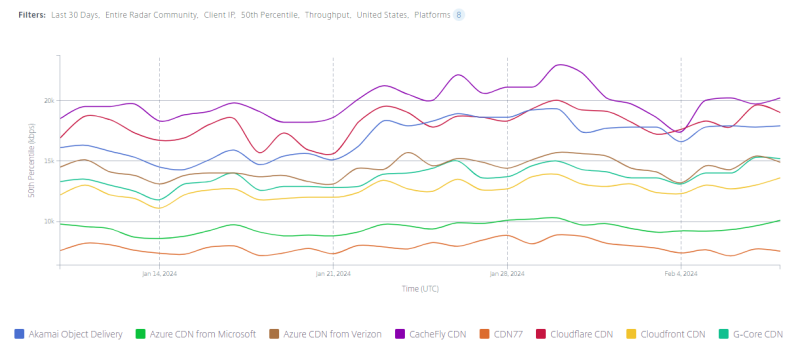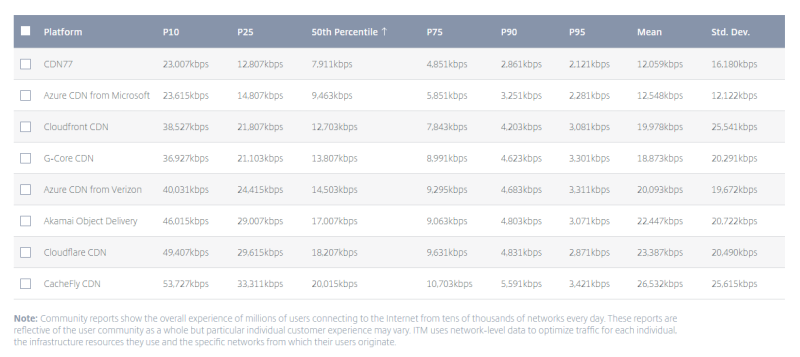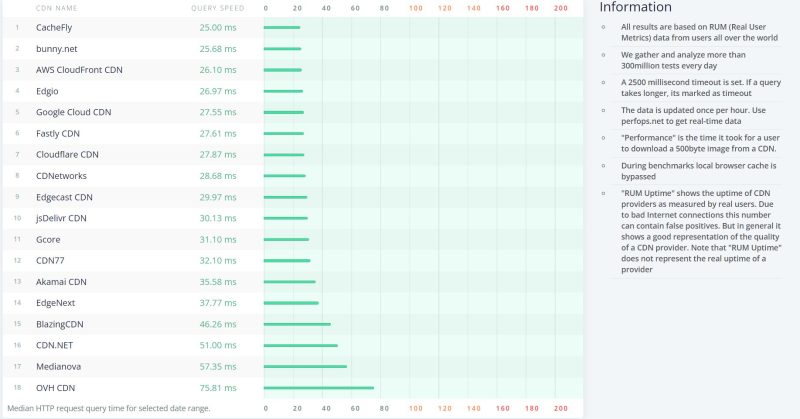
The World’s Fastest Content Delivery Network for 20+ Years
When you’re pushing petabytes of data. You deserve to be in control.
At CacheFly we’re not just a provider, we’re a partner.
CacheFly’s ultra-fast static and dynamic content delivers the highest stability and throughput globally.
But don’t take our word for it. See the latest report by Cedexis by Citrix.


Be it static or dynamic content, CacheFly delivers the highest throughput over our leading-edge global network to ensure your content is lightning-fast, secure, and reliable for users on any device.
Our vast global network, which is one of the fastest on the planet, is trusted by some of the most demanding web properties pushing petabytes of data to deliver streaming, gaming and innovative edge experiences designed to delight and excite the most demanding customers.
The CacheFly network can reach about 95% of the world’s population in under 50 ms with millions of concurrent users. We’re also here to safeguard your digital content delivery with a 100% Cache Hit Ratio, no buffering, and guaranteed QoS with our Storage Optimization System (S.O.S). We’ll keep your content cached, avoiding trips to your origin, and optimizing download speeds.
No matter where your customers are, S.O.S makes content delivery faster. With no cache misses, they’re never being redirected to the origin. CacheFly’s Storage Optimization System is a dedicated storage space for only you, allowing you to keep your data and content closer to your customers without your neighbor’s–and sometimes your competitor’s–traffic reducing the experience of your customers.
How to Measure Performance When Using a CDN
A content delivery network, or CDN, is network of servers distributed globally designed to speed content delivery. When someone uses a CDN to get a file from a website, the file is sent from the server that is closest to them. The website will work much better with this delivery method because the file won’t have to travel as far.
There are several different ways to measure the performance of a CDN. Some of the most common metrics include:
- Response time: The time it takes for the CDN to respond to a request.
- Bandwidth: The data transferred between the CDN and the user.
- Error rate: The percentage of requests that fail.
In addition to these metrics, it is also essential to consider the following factors when measuring the performance of a CDN:
- Geographic location: The distance a user is from the content being delivered can have a significant impact on the performance of the CDN.
- Type of content: The type of content being delivered can also affect performance. For example, high-resolution images, video file and gaming downloads tend to be larger than text files, so they will take longer to deliver.
- Traffic patterns: The amount of traffic that a website receives affects performance. The CDN can scale to handle the load as a website gets increased traffic. For example, when millions of users concurrently access streaming video CDNs can help expand server bandwidth based on demand.
Various tools measure the performance impact of a CDN. Some of the more popular ones include:
- Google PageSpeed Insights: This tool provides several metrics to measure a website’s performance.
- WebPageTest: This tool allows users to run different tests on a website, including performance tests.
- Pingdom Website Speed Test: This tool provides a simple way to measure a website’s performance.
Once you have information about how well your CDN is working, you can use it to find ways to make it work better. In this case, if the response time is always long, you might need to move the CDN closer to your users. Or, if there are a lot of errors, you might need to fix how the CDN is set up.
Regularly checking your CDN’s performance will help you make sure it gives your users the best performance possible.
Examples of CDN Performance Metrics
Here are some examples of CDN performance metrics that you can track:
- Response time: The average time it takes for a user to receive a response from the CDN.
- Bandwidth: The total amount of data transferred between the CDN and the user.
- Error rate: The percentage of requests that fail.
- Content delivery time: The total time it takes for a user to receive a complete file from the CDN.
- Page load time: The total time it takes for a user to load a web page.
- User satisfaction: The percentage of users who are satisfied with the performance of the CDN.
Tracking these metrics allow you to understand better how your CDN is performing while identifying areas for performance optimization.
How to Improve CDN Performance
Here are a few steps you can take to improve the performance of your CDN, including
- Choose the correct CDN provider: Several providers are available. Some factors to consider when selecting a CDN provider include the geographic locations of your users, the types of content you are delivering, and your budget.
- Configure your CDN correctly: Once you have chosen a provider, this step includes setting up the correct geographic locations and selecting the proper caching settings.
- Monitor your CDN performance: Once your CDN is up and running, you should monitor the performance. Monitoring will help you identify any potential problems and take steps to fix them.
- Optimize your content: You can also improve the performance of your CDN by optimizing your content. Standard optimizations include things like compressing images and minifying CSS and JavaScript files.
If you follow these tips, your CDN will work better and give users a better experience.
Putting It All Together
Here is an example of a webpage loading time without a content delivery network (CDN) and with a CDN.
Without a CDN:
- The user is located in the UK.
- The website’s origin server is located in North America.
- The webpage contains images, CSS, and JavaScript files.
- The total size of the webpage is 15MB.
The webpage will take approximately 7 seconds to load. This is because the user’s computer must request all of the files from the origin server in California. The files must then travel across the Atlantic Ocean, to ultimately be delivered to the users internet device in London adding to the loading time.
With a CDN:
- The same user is located in London, in the United Kingdom.
- The website’s origin server is located in Los Angeles, California in North America.
- The webpage contains images, CSS, and JavaScript files.
- The CacheFly CDN has a point of presence (PoP) in London.
The webpage will take approximately <1 seconds to load. The user’s computer must only request the files from the CDN’s PoP in the United Kingdom. The files must only travel a short distance, significantly reducing the loading time.
Positive benefits of using a CDN:
- Faster page load times
- Improved user experience
- Reduced data transfer and bandwidth costs
- Increased website availability
- Improved website security
Negative benefits of using a CDN:
- Additional costs
- Increased complexity managing global content delivery
- Security risks if your CDN provider doesn’t offer DDoS, WAF, SSL, and more.
Overall, the benefits of using a CDN outweigh the negatives. If you’re looking to improve your web performance, using a CDN is the most common way.
Measuring What Matters To You
Other performance monitoring systems that are free and publicly available like CDNPerf measure the transfer of very small data packets to populate their ranking. While CacheFly typically will rank high here too, it’s important to understand your website data density. CacheFly can handle petabytes of data and millions of concurrent users setting us apart from other CDNs that specialize in supporting thousands of very small businesses.
![]()

The best way to determine which CDN is best for you is to sign up for a free test account to tinker or schedule a demo to talk to an expert today.
At CacheFly, we know you’re not just in the market for a content delivery network, you’re looking for a competitive edge. That means you need a CDN solution that adapts to your unique requirements, not the other way around.
The problem is the world is full of one-size-fits-all platforms that treat your account just like all the others. Which makes you feel like a square peg being forced into a round hole.
We believe that when you’re pushing petabytes of data every month, you deserve to be in control. We understand that your success is directly tied to content delivery. That’s why at CacheFly, you can toggle and tailor every CDN setting to create your ideal solution. Plus, you can count on personalized help anytime from a tenured expert who gets it — engineer to engineer. Their people have call center scripts. Ours have commit privileges.
And sure, we have the fastest global throughput on Earth, unmatched versatility, and over 20 years in business. But partnering with us isn’t just about our performance obsession and long-term reliability. It’s about gaining an extension of your team that eats, sleeps, and breathes content delivery.
Here’s how we’ll power up your content’s performance:
- Check out our tech: Sign up for a free test account to tinker or schedule a demo to talk to an expert.
- Make it your own: Plan the tailored deployment you need with white glove support from our team.
- Set it and forget it: Enjoy your new competitive advantage.
We’re here if you need us… 24/7/365. So, sign up for a free test account today for a hands-on tour under the hood. And while you’re at it, schedule a demo and get to know your new CDN dream team.
It’s time to stop letting inflexible platforms hold you back and get the unparalleled performance, control, and white-glove support that will give you the edge you want.
Product Updates
Explore our latest updates and enhancements for an unmatched CDN experience.
Book a Demo
Discover the CacheFly difference in a brief discussion, getting answers quickly, while also reviewing customization needs and special service requests.
Free Developer Account
Unlock CacheFly’s unparalleled performance, security, and scalability by signing up for a free all-access developer account today.
CacheFly in the News
Learn About
Work at CacheFly
We’re positioned to scale and want to work with people who are excited about making the internet run faster and reach farther. Ready for your next big adventure?




